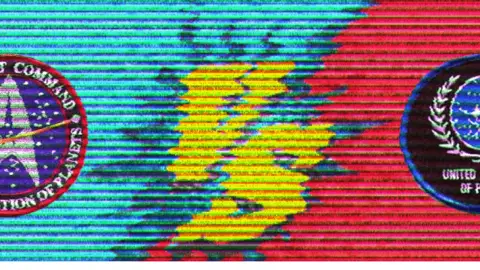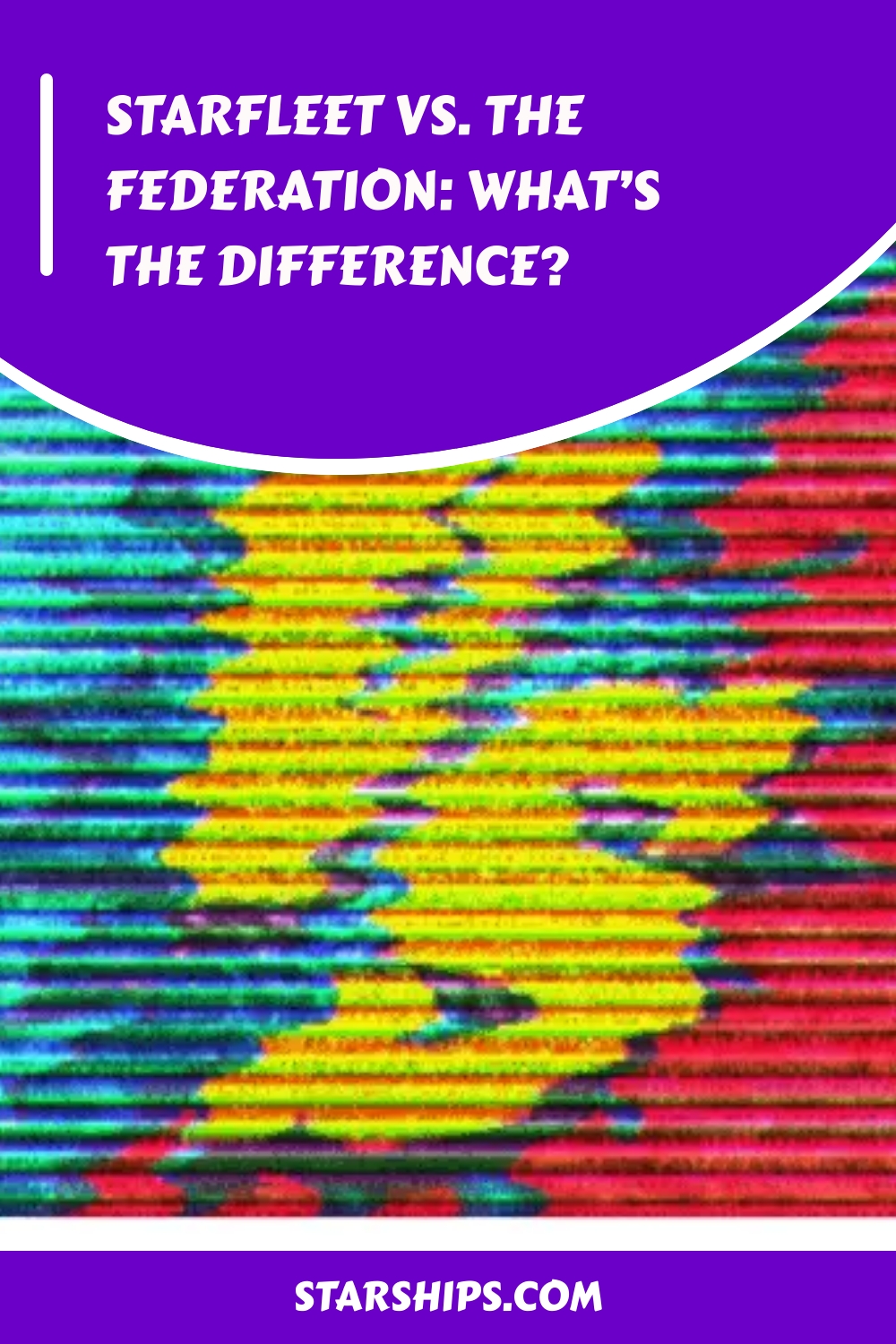The Federation and Starfleet go hand-in-hand on most Star Trek series and movies, so when people think of one, they automatically think of the other as the same entity. But that can’t be further from the truth, as they have as much in common with each other as the United States and the military have in common today. So what is the difference between the Federation and Starfleet?
The Federation is a union of planets, while Starfleet is a type of military organization commissioned for exploration and defense. Starfleet was formed before 2119 and funded the voyage of the first Enterprise. The Federation came about several years later as a result of Captain Archer’s voyages.
While many people might confuse the Federation with Starfleet, it’s quite simple. Read on to learn the differences for yourself!
The Federation is a Union of Planets
Much like the United Nations, the Federation is a union of many planets throughout the galaxy for protection and shared resources. The inhabitants of each planet work together for all people’s good, including defense against hostile forces.
But the Federation is not appreciated for what it is by other races.
Cardassians, Romulans, and for a time, Klingons chose not to join the Federation. They saw the Federation as a group of “peace-loving weak-willed people” who have no honor because they did not fight for their rights. The Federation, however, will fight for justice but will work to find a diplomatic solution should the need arise.
Federation Territory
Federation space extends about thirty thousand light-years from the center of the galaxy, and it covers the Alpha and Beta quadrants. While many planets within this area are member planets, much of this area covers pre-warp civilizations and uninhabited space regions. Visitors to Federation space are subject to health and safety inspections so as not to endanger anyone.
In 2267, there were about a thousand planets that had the privilege of membership in the Federation. One hundred years later, there were countless M-class planets and over 150 member planets within Federation space.
Federation Governing Bodies
Much like Earth’s democracies, the Federation is governed by three separate branches:
- The executive branch oversees the daily management of the Federation, including foreign policy, budgetary concerns, and the military. A democratically elected president governs from Earth with the executive cabinet made up of several department heads.
- The legislative branch oversees the laws of the Federation while influencing foreign policies. The legislative council sometimes serves as a judging body in special court-martials, such as when Admiral Kirk went against Starfleet orders to retrieve Spock from the Genesis planet.
- The judiciary branch is responsible for solving legal disputes. The Federation Supreme Court sat at the head of the branch, with several smaller courts for civilian matters. Starfleet also had their court under this branch that dealt with court-martials.
Membership Into the Federation
Only those planets who developed warp capabilities were eligible to apply for membership in the Federation. Or they could be invited to join the Federation if they were deemed “right” for the Federation. There had to be several other factors in place before they would be approved.
The following requirements would ensure membership:
- Civilization must have advanced technology that would allow them to travel faster than light.
- There is political and cultural unity among the planet’s residents.
- The rights of all residents must be assured, and no one must be discriminated against.
- There is to be no caste system on the planet.
Planets must apply and show that they meet the requirements. Although the Federation made allowances for certain planets, this was rare, and it is not usually done.
During the war with the Dominion, the Federation was approving member planets more quickly, as they needed as much help as they could get.
Starfleet Is a Military Organization
Starfleet is an organization of officers that go on diplomatic missions, explore space, seek out new life and new civilizations, and to “boldly go where no one has gone before.” It is as if they merged all the United States’ military branches and blasted them into space. Starfleet got its start in 2135—almost 20 years before the first Enterprise was launched to explore the galaxy.
However, Gene Roddenberry wanted people to know that Starfleet was not a military organization per se, but more like the Coast Guard. He wanted people to understand that Starfleet was more altruistic than militaristic, even though many episodes depicted a military format.
Starfleet Organization and Officer Rosters
Every military has a hierarchy, from the top brass down to the grunts who do all the work no one else wants to do. Starfleet covers a wide range of departments, with officers in all departments. The departments cover everything from administration to the Corps of Engineers to the exploration division.
Anyone who graduated from Starfleet Academy automatically had Ensign’s rank and would move up the officer ranks throughout their service aboard the starships. The service officer classes are as follows:
- Ensign
- Lieutenant Junior Grade
- Lieutenant
- Lieutenant Commander
- Commander
- Captain
Once someone is promoted from the captain, they begin having diplomat jobs or administration jobs that take them off a ship’s bridge. Captain Kirk told Captain Picard in “Generations” to not let anyone promote him or do anything that will take him off the bridge of his ship, where he could make a difference.
From there, the officer designations are:
- Commodore
- Rear Admiral
- Vice Admiral
- Admiral
- Fleet Admiral
Enlisted personnel were seen on older ships, but were not as common on ships past Captain Picard’s era and beyond.
Starfleet Regulations
As with any military organization, Starfleet has established regulations to make sure it runs smoothly and efficiently. These regulations govern how a ship is to be run, how the first contact with alien species is to be conducted, and all officers’ appearance.
Without these regulations, ship captains with less honor would be tempted to take advantage of weaker species to protect their crew and ship.
- The Federation Council must approve giving weapons to other races before doing so.
- If transmissions were being monitored during a battle, no uncoded messages are to be sent.
- The captain and first officer of any ship cannot be on the same away mission at any time.
- The Uniform code regulated how officers were to present themselves and their appearances.
Many regulations were bent or broken during many missions, including the Prime Directive. However, in most instances, the missions turned out for the best, and not too many people were harmed.
Starfleet Directives
As different crews made contact with new life and new civilizations, situations came up that made directives a necessity for future contact with civilizations. The number one Prime Directive came after Captain Archer and his crew encountered two races—one with a terminal illness and one without—and decided not to interfere with the normal course of evolution. Eventually, the Prime Directive of non-interference was adopted in 2168.
Other directives, or “general orders,” include some of the following principles:
- Starfleet shall not enact a death penalty in any circumstance.
- Upon a starship’s approach and communication is not established, the ship must go to Red Alert.
- The Omega Directive was one that only captains and higher knew of, and it was that they must destroy any omega molecules found, regardless of the need to explore.
- The Temporal Prime Directive was established sometime before the 29th century, and it was to maintain the timeline and prevent any alterations to it.
Directives were meant to keep Starfleet officers from interfering with other cultures, maintain order within their ships, and to keep the peace.
Starfleet Away Team Protocol
Away teams are an important part of Starfleet’s mission to seek out new life and new civilizations. Aside from the Prime Directive, away teams need to adhere to several other regulations and protocols to keep themselves and their team safe, as well as not harming any life on the planets they visit.
Some of the regulations include but are not limited to remaining armed and ready to defend themselves until contact is made, keeping an open com channel at all times, and being composed of more than one crew member.
These protocols were put into place to provide the away team with a framework to explore without the risks and dangers keeping them from furthering Starfleet’s mission.
Starfleet Ships
As the exploration and defensive division of the Federation, Starfleet must have the cutting edge in technologically advanced ships to transport supplies, provide emergency medical care, and explore new worlds.
The fleet of ships would not contain any warships or ships made specifically for the destruction of others, which was a mandate from the 24th century. Exceptions were made at the beginning of the war with the Dominion.
There were several classes of starships, the most famous being the Constitution-class starship, of which Captain Kirk and crew operated by the Enterprise in the Original Series. When the ship was refit, it took 18 months to re-do all the wires, consoles, and engines.
By the time Enterprise-D came along, they were using Galaxy-class starships and other, more advanced ships in the fleet. Voyager was an Intrepid-class ship.
In 2257, there were seven thousand ships in the fleet, and it continued to go up from there.
Which Came First: The Federation or Starfleet?
Unlike the chicken vs. the egg quandary, it is clear which organization came first: Starfleet was the first Enterprise’s funding source that saw Captain Jonathan Archer at its helm. Captain Archer was one of the founding members of the Federation in 2161 after his voyages came to an abrupt end.
A Brief History of Starfleet
Before 2161, Starfleet was the primary space exploration agency of United Earth, while Starfleet’s commanding agency was either Starfleet Command or the United Earth Space Probe Agency. Their headquarters were located in San Francisco, where they eventually built Starfleet Academy.
Early Starfleet’s primary objective was to build an efficient engine that would allow spaceships to cross a vast distance in a relatively short time. By the 2150s, they created a Warp 5 ship, despite the lack of assistance from the Vulcans.
The Vulcans had developed warp drive sometime after 1947, but they only achieved higher than warp 2 in 2047. But they did not share their knowledge very easily with humans, leading to the distrust and annoyance from humans, as they were mostly left to figure out how to create higher speed engines.
After the Federation was formed, Starfleet became governed for a time by the Federation governing body. But by the 24th century, Starfleet had their chain of command, while the Federation had other, more important issues to keep them occupied.
A Brief History of the Federation
While the Federation got its start in 2161, a year after the Earth-Romulan War, the Federation’s seeds were planted when Zephraim Cochrane made his maiden voyage with his warp-capable ship. The Vulcans saw the flight and came to Earth to meet the man who flew the ship out of interest.
Once Earth got into space and began meeting other races, they started working together for the good of each other. Old war allies from the war with Romulans, such as the Andorians, Vulcan, and Tellerites, together with Humans, formed the beginnings of the United Federation of Planets.
Jonathan Archer became a Federation ambassador in 2169, then was elected as the Federation President in 2184.
By the late 22nd century, the new world economy became a reality, and money, wealth, and power became relics of the past. Without the worries of food and shelter, people were free to pursue their interests and become who they were meant to be, which led the way to greater technological and medical developments. War, poverty, and disease were all wiped out shortly afterward.
Going forward, the Federation had uneasy relations with the Romulans and Klingons. The neutral zone was established after the Romulan-Earth war, and neither side was to cross over to enemy territory. Doing so would be considered an act of war, giving the other side cause to retaliate.
The Federation met with many enemies, but the most notorious enemy was the Borg. The Enterprise-D crew was the first crew to come into contact with them as a result of Q flinging them into unchartered space, which was most likely the Delta Quadrant, 70,000 or more light-years from Earth.
The Borg were hybrid cybernetic and biological creatures that assimilated entire planets and races for their technological advancements. They were formidable and difficult to defeat. But somehow, Earth managed to always escape assimilation, either through time travel or through prior knowledge of borg ships.
Starfleet Furthers the Federation’s Agenda
Though Starfleet appeared before the Federation of Planets, they are used to further the agenda of the Federation. While most missions of the Federation are peaceful, some missions could have been seen as aggressive, according to the Klingons.
In Star Trek: Discovery, the Klingons deeply opposed any race who said they “come in peace,” as they see that as a sign of weakness. Klingons of the late 22nd century and early 23rd century viewed Humans, and all of the Federation, as weak, yet deceptive. Coming in peace may mean, according to Klingons, that they are trying to trick them and are planning on destroying them later.
However, the Federation’s agenda is once of peace and exploration. Starfleet is the main organization that carries out its agenda and assists other planets with their needs.
The Federation Is Comprised of Several Planets and Races
The founding members of the Federation include Humans, Andorians, Vulcans, and Tellerites. Later, other member races were added, including Betazoids and Klingons (after their moon blew up). Countless M-class planets are members of the Federation and receive medical care, supplies, and defense from hostile forces. They are also allowed to join Starfleet and become valuable members of a starship crew.
Only Members of the Federation Can Join Starfleet
While Starfleet’s “official” policy is to admit only members of the Federation of Planets, Starfleet has been known to admit members from non-Federation planets. Anyone wanting to join Starfleet Academy would need a letter of recommendation from a command-level officer before being considered entrance into the academy.
For example, a Ferengi teenager, Nog, wanted to join Starfleet. However, Ferenginar is not part of the Federation. He needed to get a letter of recommendation from Commander Benjamin Sisko of DS9 starbase.
Conclusion
The Federation and Starfleet are similar in that they want to create peace with other races and planets. But that is where that ends, as they have very different agendas and governing bodies. Starfleet is an organization that trains officers and crew to live in space while seeking out new life and new civilizations. The Federation is in place to provide order and law for all planets.
While the Federation stands for peace, they often encountered many who would topple that peace as a means to control more space and territories, which was a rude wake-up call to the Federation.
Sources
- Memory Alpha: Federation History
- Memory Alpha: Vulcan History
- Continuing Mission: History of the Federation, Part 1
- Continuing Mission: History of the Federation, Part 2
- Memory Alpha: Starfleet
- Memory Alpha: Starfleet General Orders and Regulations
- Memory Alpha: Temporal Prime Directive
- Memory Alpha: Omega Directive
- Wikipedia: Starfleet
- UF Starfleet Wikipedia: Timeline of the Federation
- Memory Alpha: Federation Members
- Memory Alpha: United Federation of Planets
- Memory Alpha: Dominion
- Memory Alpha: Prime Directive





Leave a comment
You must be logged in to post a comment.